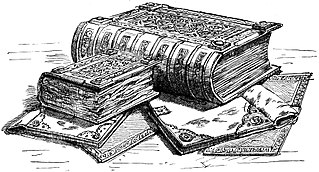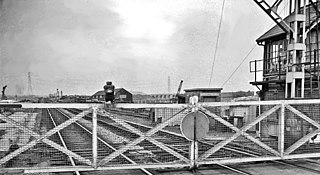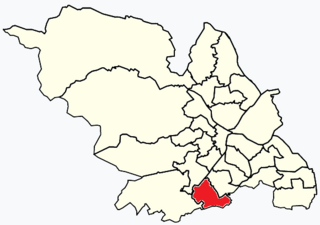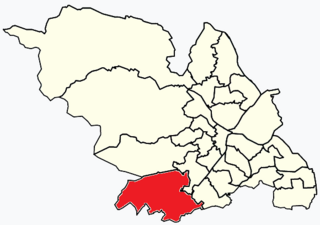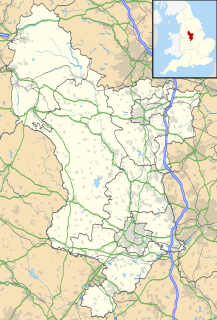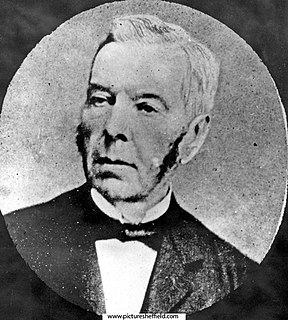It has been requested that the title of this article be changed to Beighton Ward . Please see the relevant discussion on the discussion page. The page should not be moved unless the discussion is closed; summarizing the consensus achieved in support of the move. |
| Beighton | |
|---|---|
 Shown within Sheffield | |
| Population | 17,939 (2011) |
| District | |
| Ceremonial county | |
| Region | |
| Country | England |
| Sovereign state | United Kingdom |
| EU Parliament | Yorkshire and the Humber |
| UK Parliament | |
| Councillors | Helen Mirfin-Boukouris (Labour Party) Christopher Rosling-Josephs (Labour Party) Ian Saunders (Labour Party) |
Beighton ward ( /ˈbeɪtən,

Sheffield is a city and metropolitan borough in South Yorkshire, England. Historically part of the West Riding of Yorkshire, its name derives from the River Sheaf, which runs through the city. With some of its southern suburbs annexed from Derbyshire, the city has grown from its largely industrial roots to encompass a wider economic base. The population of the City of Sheffield is 577,800 (mid-2017 est.) and it is one of the eight largest regional English cities that make up the Core Cities Group. Sheffield is the third-largest English district by population. The metropolitan population of Sheffield is 1,569,000.

England is a country that is part of the United Kingdom. It shares land borders with Wales to the west and Scotland to the north-northwest. The Irish Sea lies west of England and the Celtic Sea lies to the southwest. England is separated from continental Europe by the North Sea to the east and the English Channel to the south. The country covers five-eighths of the island of Great Britain, which lies in the North Atlantic, and includes over 100 smaller islands, such as the Isles of Scilly and the Isle of Wight.
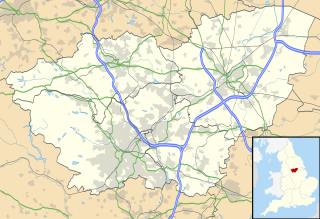
Rotherham is a town in South Yorkshire, England, which together with its conurbation and outlying settlements to the north, south and south-east forms the Metropolitan Borough of Rotherham, with a recorded population of 257,280 in the 2011 census. Historically in the West Riding of Yorkshire, its central area is on the banks of the River Don below its confluence with the Rother on the traditional road between Sheffield and Doncaster. Rotherham was well known as a coal mining town as well as a major contributor to the steel industry.
Contents
Before 1967, the districts of this ward formed part of Derbyshire. In that year an extension of the then County Borough of Sheffield took in the area, which was consequently transferred to the West Riding of Yorkshire. [3] In 1974 the area became part of the City of Sheffield, in the metropolitan and ceremonial county of South Yorkshire. [4]

Derbyshire is a county in the East Midlands of England. A substantial portion of the Peak District National Park lies within Derbyshire, containing the southern extremity of the Pennine range of hills which extend into the north of the county. The county contains part of the National Forest, and borders on Greater Manchester to the northwest, West Yorkshire to the north, South Yorkshire to the northeast, Nottinghamshire to the east, Leicestershire to the southeast, Staffordshire to the west and southwest and Cheshire also to the west. Kinder Scout, at 636 metres (2,087 ft), is the highest point in the county, whilst Trent Meadows, where the River Trent leaves Derbyshire, is its lowest point at 27 metres (89 ft). The River Derwent is the county's longest river at 66 miles (106 km), and runs roughly north to south through the county. In 2003 the Ordnance Survey placed Church Flatts Farm at Coton in the Elms as the furthest point from the sea in Great Britain.
County borough is a term introduced in 1889 in the United Kingdom of Great Britain and Ireland, to refer to a borough or a city independent of county council control. They were abolished by the Local Government Act 1972 in England and Wales, but continue in use for lieutenancy and shrievalty in Northern Ireland. In the Republic of Ireland they remain in existence but have been renamed cities under the provisions of the Local Government Act 2001. The Local Government (Wales) Act 1994 re-introduced the term for certain "principal areas" in Wales. Scotland did not have county boroughs but instead counties of cities. These were abolished on 16 May 1975. All four Scottish cities of the time — Aberdeen, Dundee, Edinburgh, and Glasgow — were included in this category. There was an additional category of large burgh in the Scottish system, which were responsible for all services apart from police, education and fire.

The West Riding of Yorkshire is one of the three historic subdivisions of Yorkshire, England. From 1889 to 1974 the administrative county, County of York, West Riding, was based closely on the historic boundaries. The lieutenancy at that time included the City of York and as such was named West Riding of the County of York and the County of the City of York.



